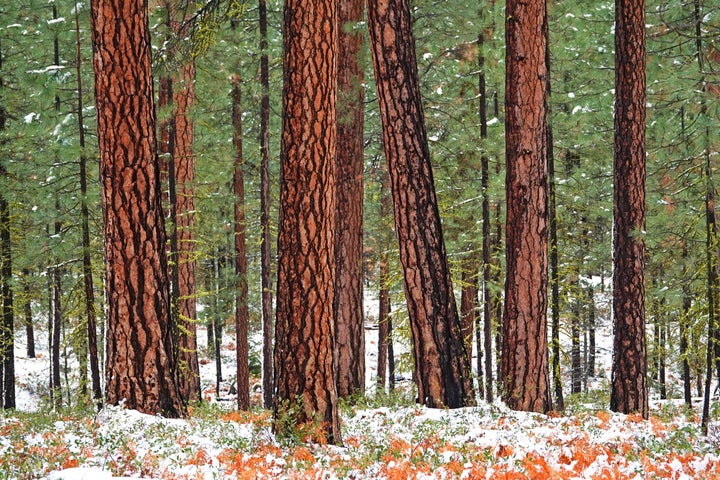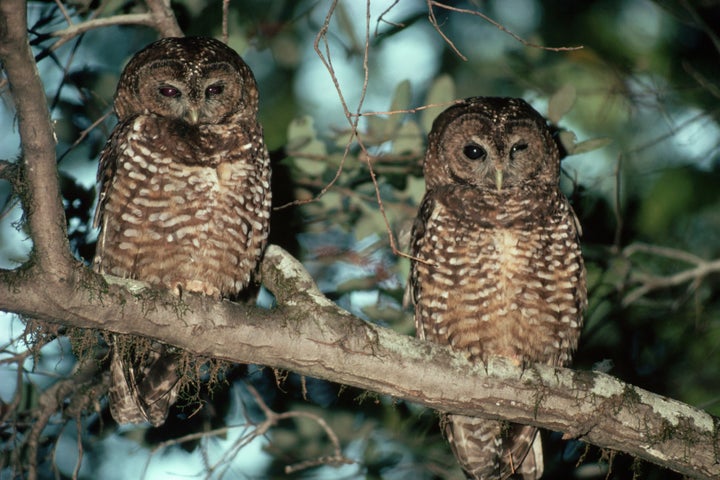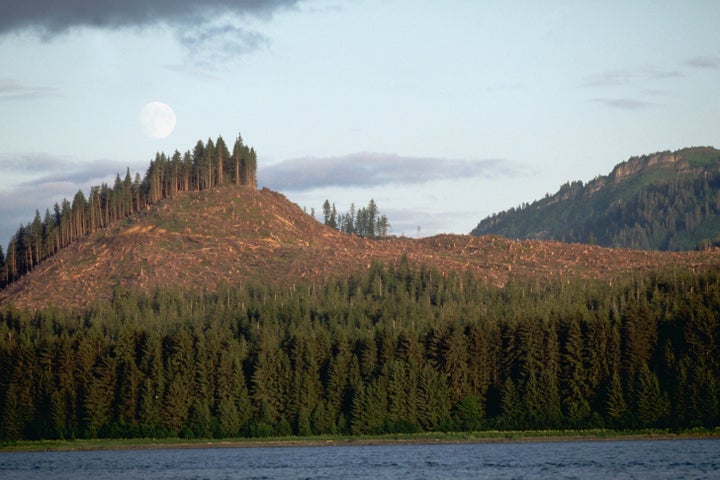In the Cascade Mountain Range of west-central Oregon, near the small town of MacKenzie Bridge, is an area of Willamette National Forest that’s home to a patchwork of mature Douglas fir and western hemlock. The oldest are between 120 and 150 years, towering more than 100 feet.
Few mature forests remain in the continental United States after decades of intensive logging. And, like so many before them, these trees could soon be gone as the U.S. Forest Service moves ahead with a plan that would allow about 2,000 acres to be cut down in what’s known as the “Flat Country” project.
The Biden administration is pushing an aggressive environmental agenda, pledging to both slash greenhouse gas emissions at least in half and to conserve 30% of America’s lands and waters by 2030. Those commitments include broad language about the need to “invest in forest protection and forest management” and to “fight climate change with the natural solutions that our forests, agricultural lands, and the ocean provide.”
But President Joe Biden and his team have said little, if anything, about old-growth forests — typically defined as those at least 150 years old and largely undisturbed by human activity. These forests sequester massive amounts of carbon in trees and soil, and scientists say protecting the few that remain intact will prove key to meeting climate and biodiversity targets. That includes the 2,000 acres its own Forest Service is primed to move forward on after issuing its final record of decision in January.
Retired forestry professors Jerry Franklin of the University of Washington and Norm Johnson of Oregon State University helped write the forestry plan that made this area available for potential harvest. Adopted in 1994, the plan sought to curb the decline of northern spotted owls due to clearcutting of old-growth forests while continuing to allow for commercial timber production.
More than two decades later, Franklin and Johnson are speaking out against this and other plans to cut down mature forests, citing the climate and extinction crises. Our scientific understanding of such ecosystems, including their ability to store huge amounts of planet-warming carbon pollution, has improved immensely since then, the two wrote in a recent opinion article.
“It is time to stop logging magnificent mature forests like those in the Flat Country Project once and for all,” they wrote. “These forests simply contribute too much ecologically, socially and spiritually in their current state.”

The Biden administration’s lack of a strong commitment to stop logging areas like this and in Alaska’s Tongass National Forest, the world’s largest intact temperate rainforest, is a “big concern of scientists,” said Beverly Law, a professor emeritus at Oregon State and an expert on the forest carbon cycle.
“Once they are gone, these are trees that have stored [carbon] for hundreds of years, it will take that long to gain it back,” she said. “It also means that most of that carbon is going to go back to the atmosphere in the next few decades. And that’s not going to help us get any closer to meeting our climate goals. It’s going to make the situation worse.”
Pressure To Protect What’s Left
Before Biden was sworn in, his transition team invited Law to submit a scientific position paper on forests and climate mitigation. In it, she and more than a dozen other forest ecology and climate experts called for mature and old temperate forests in Alaska and the Pacific Northwest to be permanently set aside as National Strategic Carbon Reserves.
Law is also working on a comprehensive study to map forested areas with the potential for increased protections, a follow-up to one she co-authored in 2019 that identified forests in the Western United States with a high potential for store carbon and harboring a diversity of plant and animal species.
Preserving ancient forests is a “win-win” for climate and biodiversity, Law told HuffPost.

Biden and his team are facing mounting pressure to do just that as part of the fight to stave off potentially catastrophic climate change.
In a letter last month, dozens of environmental groups, including the National Resources Defense Council and Earthjustice, called on the Biden administration to make the protection of carbon-rich forests a central part of its push during the United Nations climate conference in Glasgow, Scotland, in November.
“Establishing permanent protections for temperate rainforests in the Pacific Northwest and Alaska, along with mature federal forests and trees nationwide, will be one of the most cost-effective and essential near-term climate solutions the United States can employ,” the groups wrote.
It’s hard to overstate the importance of Alaska’s 17-million-acre Tongass National Forest, known as “America’s Amazon.” It stores about 8% of the total carbon isolated in forests in the Lower 48 states, according to the U.S. Department of Agriculture, and an astonishing 44% of all carbon stored in national forests across the United States.
In the Lower 48, about 7% of forests remain intact ― most of them in the Pacific Northwest.
The ‘Elephant In The Room’
Oregon Wild is among the groups pushing the Biden administration to protect what little is left. Last month it launched a website detailing the important role of healthy, mature forests and highlighting active old-growth logging projects, in various stages of development, that could affect about 800,000 acres in Alaska, Oregon, California and Washington.
Steve Pedery, conservation director at Oregon Wild, questions whether Biden’s action on forests will match his rhetoric about climate change being an all-hands-on-deck, no-solutions-off-the-table emergency. He called forests in the Pacific Northwest the “elephant in the room” and said his fear is that the Forest Service ― an agency established in 1905 primarily to ensure a steady supply of timber — will be left to its own devices and continue to “bleed carbon” from remaining forest ecosystems.
The Trump administration prioritized logging, drilling and other resource extraction across federal lands and repeatedly blamed extreme wildfires on forest mismanagement resulting from lawsuits by “environmental extremists.” It also obliterated protections for Tongass, lifting Clinton-era logging restrictions across 9.3 million acres and reclassifying 188,000 acres, including 168,000 acres of old growth, as immediately suitable for harvesting.
Biden signed an executive order his first day in office directing the Department of Agriculture to review Trump’s rollback in Tongass, but the findings are not yet public, and protections have not been officially restored.

Environmentalists have welcomed the forest protection and reforestation language that appear in Biden’s climate and conservation commitments. For example, his job and infrastructure plan, released in March, calls for major investments to “protect and, where necessary, restore nature-based infrastructure ― our lands, forests, wetlands, watersheds, and coastal and ocean resources.”
But they are also waiting to see how this plays out in reality.
The White House referred HuffPost’s questions on logging and forest protection to the Interior and Agriculture Departments. Forest Service spokeswoman Babete Anderson told HuffPost that the “old growth” term “can have a wide variety of definitions and meanings” depending on ecological settings and forest types and that “the Forest Service does not have a one-size-fits-all policy to guide management decisions.”
Instead, a number of environmental laws, land use designations and local conditions guide forest management decisions, Anderson said.
Pedery argues that given the urgency of the climate and extinction threats, old-growth logging should go the way of whaling, which was banned at the federal level in 1971.
“There were a lot of people who were hurt by that change, but it was a change that needed to happen,” he said. “Killing whales is not a sustainable business model. Logging old growth is the same.”
“You might have the most high-tech commercial whaling vessel in the fleet,” he added, “but you’re still killing whales.”
Though Biden has remained silent about old-growth logging at home, he is pressuring Brazil’s far-right president, Jair Bolsonaro, to curb deforestation in the Amazon. On the campaign trail, Biden said he’d mobilize nations to pay Brazil $20 billion to keep the South American country from destroying the rainforest.
The Brazilian government has swung back at Biden, at times pointing out the United States’ own history of razing its forests.
“You’re asking us to solve a problem that you created and are continuing to aggravate,” Brazilian Environment Minister Ricardo Salles recently told Politico. “We want you to help solve our problems with lack of prosperity and economic opportunity in the Amazon region.”
